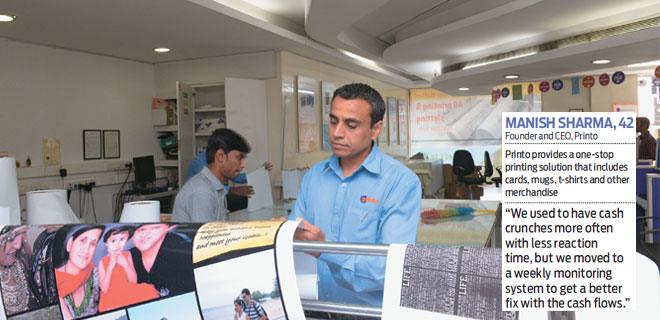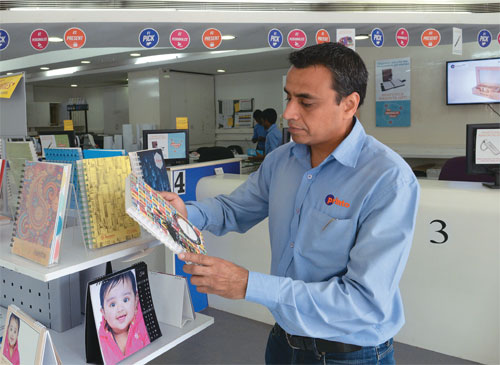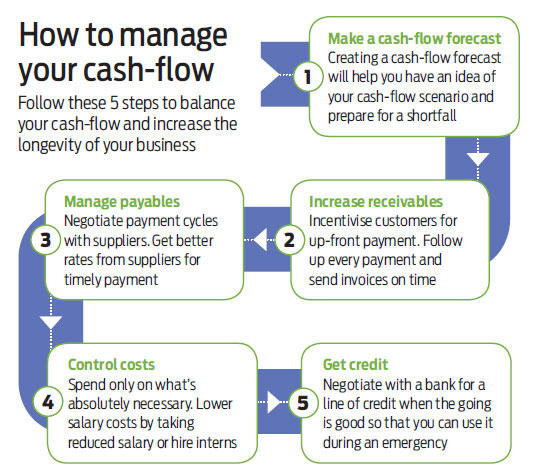Tackle the cash flow demon
Getting your finances in order is crucial to the health of your business. We tell you how

American businessman and former Congressman Chris Chocola had hit the nail on the head when he said, “The fact is that one of the earliest lessons I learned in business was that balance sheets and income statements are fiction, cash flow is reality.” And this is a reality most businesses fail to deal with.
Statistics say that 90 per cent of small business failures are caused by poor cash flow. What it means is that there is not enough cash coming into the business while too much is going out. Cash flow is the fuel that your business runs on. Once you are out of fuel, you are no longer in the competition.
An entrepreneur’s journey is full of challenges, and getting a grip on the cash flow is the first step to success. A smart way is to make a cash flow forecast, which will help you figure out how much money will flow in through sales and how much would flow out through payments, salaries and other expenses, over a given period. The difference between the receivables and the payables is your cashflow. One of the reasons for start-ups to lose focus on cash flows is their hurry to grow, which takes away the focus from cash flows. Very few realise that unlike revenues, which vary, costs are fixed.

Says Manish Sharma, founder and CEO, Printo, a Bangalore-based printing solutions company, “Every year, when we prepare the annual budget, we create a cash flow projection from the projected profit and loss and the planned investments. This determines how much credit we may need for the year.”
Cash flow, unlike profits, has more to do with cash in hand. So, it is not enough just to make a sale. Till the time you don’t receive the payment, it is not counted in your cash flow.
Gym franchise chain Anytime Fitness makes quarterly cash flow forecasts by aggregating their recurring revenues and matching them with their planned and unplanned expenses. Being conservative while making cash flow projections provides one with the buffer that he would need to fall back upon.
“While managing cash flows, we budget all expected revenues at 80 per cent realisations and all budgeted expenses at 120 per cent of actual budgets,” says Vikas Jain, managing director, Anytime Fitness.
Help in hand
Fortunately, there are a host of tools available, which will help you with this. Cash flow templates in Excel or Google Docs can be a good start. You can find a template that suits best to cater to your needs and accordingly tweak it. For more serious cash flow projections, you can opt for proprietary cash flow management software, such as Pulse, Intuit QuickBook or PlanGuru. These will help you make forecasts, project different cash flow scenarios, as well as generate reports and graphics to estimate and visualise your cash flow. In the absence of an in-house expert, outsource cash flow management activities to start-ups and focus on running the company.

One way to healthy cash flows is to get paid faster than your outflows. For Massive Restaurants, a chain in the NCR, incentivising customers helps improve their cash flow.
Says Zorawar Kalra, founder and MD, Massive Restaurants: “There are some instances where we push for advance payments for large bookings. In some cases, we offer special privileges like corporate discounts to our regular corporate guests to increase sales and incentivise them.” Incentivising customers also works for Anytime Fitness, which has preset a system of incentives for cash down-payments.
Upfront payment is encouraged and preferred, and customers are pushed for availing cash discounts. But it is important to get your processes in place to ensure that payments come on time. For first time customers and small businesses, Printo has an upfront payment requirement. For larger customers they offer 30 days credit.
Smart ways to cash flow management
Incentivising payment, however, works only for larger customers and those who honour payment commitments. “We stop business with customers if payment is repeatedly not made on time. A particularly large customer is on an advance payment basis after they defaulted on timelines multiple times,” adds Sharma. What one also needs is to check on the money flowing out.

A good relationship with your suppliers and vendors is important. For instance, Printo has a 45-day payment cycle and are very diligent about paying vendors on time. “We get a better rate from vendors for an upfront payment on transactions,” says Sharma. Likewise, Massive Restaurants has tied up with vendors through yearly contracts. As part of these alliances, the suppliers offer them the best available rates and assure them of product availability throughout the year and confirmation of timely deliveries.
Tackling cash crunch
Cash crunches are common in the early stages. So, monitor your cash flow as frequently as possible. Put in place regular threshold-level checks on receipts and payments and, stick to them. Adds Sharma: “Cash crunch emergencies are usually visible 4-5 weeks ahead. We used to have cash crunches with less reaction time, but we moved to a weekly monitoring system. Today, we have some time to react and this is usually done by whipping up the receivables channel and chasing overdue payments.”
Creating a buffer is a good way to overcome this. If you do not have one, drawing credit for short-term liquidity is the only option. The Credit Guarantee Fund Trust for Micro and Small Enterprises allows a start-up to get collateral-free credit of up to Rs.1 crore. Going ahead, you might be able to use overdraft facilities from your bank or draw a line of credit. Negotiate with the bank for favourable interest rates. Says Sharma: “We use a credit facility for cash flow, which is provided by SBI against our receivables and inventory.” Here again, you need to have stringent checks in place so that you do not draw too much credit, as well as pay back on time.
Advantages of Monitoring
■ You are aware of potential gaps in cash flow and can plan to get over them
■ You can estimate how much credit you will need in times of shortfall
■ You can save and create a cushion during high income months
■ You know if you will have surplus cash
■ You can convince investors you are serious about your finances









